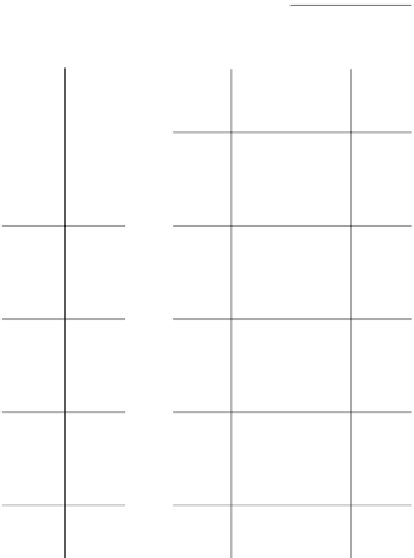Geology Reference
In-Depth Information
The instrument has a diameter of about 100 mm, an ac-
curacy of ±5 microgal, and is capable of operation in
temperatures up to 120°C and pressures up to 80 MPa.
The normal vertical spacing of observations is about 6 m
and, if depths are determined to ±50 mm, densities can
be estimated to ±0.01 Mg m
-3
, which corresponds to an
accuracy of porosity estimation of about ±1%. The
density applies to the part of the formation lying within
about five times the spacing between observations. This
is more accurate than other methods of measuring den-
sity in boreholes and can be used in cased holes. It is,
however, time consuming as each reading can take
10-20 min and the meter is so costly that it can only be
risked in boreholes in excellent condition.
Problems
1.
A sandstone, when saturated with water of re-
sistivity 5 ohm m, has a resistivity of 40 ohm m.
Calculate the probable range of porosity for this
rock.
2.
On a sonic log, the travel time observed in a
sandstone was 568
m
s over a source-receiver dis-
tance of 2.5 m. Given that the seismic velocities
of quartz and pore fluid are 5.95 and 1.46 km s
-
1
,
respectively, calculate the porosity of the sand-
stone. What would be the effect on the observed
travel time and velocity of the sandstone if the
pore fluid were methane with a velocity of
0.49 km s
-
1
?
3.
During the drilling of an exploratory bore-
hole, the rock chippings flushed to the surface
indicated the presence of a sandstone-shale se-
quence. The lateral log revealed a discontinuity
at 10 m depth below which the resistivity
decreased markedly. The SP log showed no
deflection at this depth and recorded consis-
tently low values. The gamma-ray density log in-
dicated an increase in density with depth across
the interface from 2.24 to 2.35 Mg m
-
3
.
(a) Infer, giving your reasons, the nature of the
discontinuity.
(b) What porosity information is provided by the
data?
4.
Figure 11.15 shows the SP and short normal
(including a partial expanded scale version),
long normal and lateral resistivity logs of a bore-
hole penetrating a sedimentary sequence. Inter-
pret the logs as fully as possible.
5.
Figure 11.16 shows the SP, induction, lat-
erolog, sonic, calliper and gamma logs of a bore-
Spontaneous
potential (mV)
Resistivity
(
Resistivity
(
Depth
(m)
Ω
m)
Ω
m)
16” Normal
0
10
Lateral
0
50
0
50
64” Normal
5
-
+
0
50
700
800
900
1000
1100
Fig. 11.15
SP and resistivity logs pertaining to Question 4.
(After Desbrandes 1985.)
hole in a sequence of shale and sandstone. Inter-
pret the logs as fully as possible.
6.
Two gravity readings in a borehole, 100 m
apart vertically, reveal a measured gravity differ-
ence of 107.5 gu. What is the average density of
the rocks between the two observation levels?

























